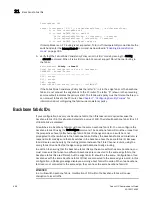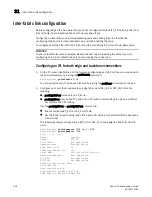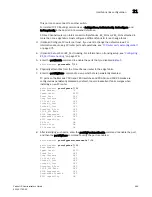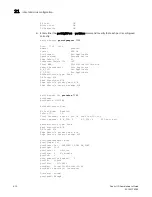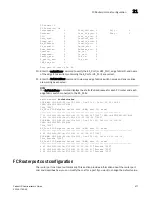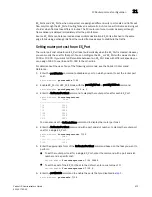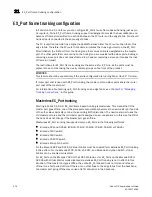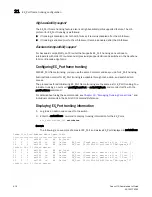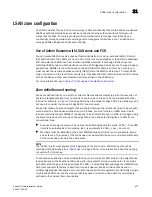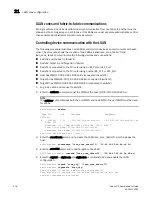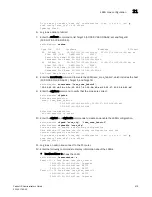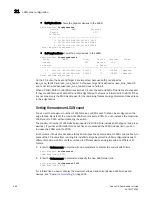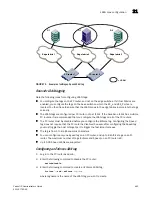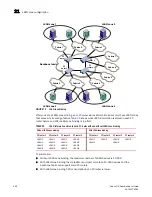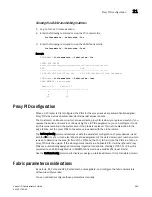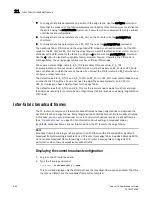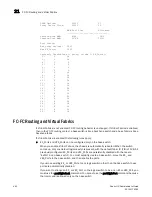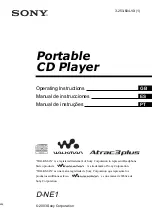
Fabric OS Administrator’s Guide
477
53-1001763-02
LSAN zone configuration
21
LSAN zone configuration
An LSAN consists of zones in two or more edge or backbone fabrics that contain the same devices.
LSANs essentially provide selective device connectivity between fabrics without forcing you to
merge those fabrics. FC routers provide multiple mechanisms to manage inter-fabric device
connectivity through extensions to existing switch management interfaces. You can define and
manage LSANs using Brocade Advanced Zoning.
Use of Admin Domains with LSAN zones and FCR
You can create LSAN zones as a physical fabric administrator or as an individual Admin Domain
(AD) administrator. The LSAN zone can be part of the root zone database or the AD zone database.
FCR harvests the LSAN zones from all administrative domains. If both edge fabrics have the
matching LSAN zones and both devices are online, FCR triggers a device import. To support legacy
applications, WWNs are reported based on the administrative domain context. As a result, you
must not use the network address authority (NAA) field in the WWN to detect an FC router. LSAN
zone enforcement in the local fabric occurs only if the administration domain member list contains
both of the devices (local and imported device) specified in the LSAN zone.
For more information, see
Chapter 15, “Managing Administrative Domains”
.
Zone definition and naming
Zones are defined locally on a switch or director. Names and memberships, with the exception of
hosts and targets exported from one fabric to another, do not need to be coordinated with other
fabrics. For example, in
Figure 70
on page 460, when the zones for Edge SAN 1 are defined, you do
not need to consider the zones in Edge SAN 2, and vice versa.
Zones that contain hosts and targets that are shared between the two fabrics need to be explicitly
coordinated. To share devices between any two fabrics, you must create an LSAN zone in both
fabrics containing the port WWNs of the devices to be shared. Although an LSAN is managed using
the same tools as any other zone on the edge fabric, two behaviors distinguish an LSAN from a
conventional zone:
•
A required naming convention. The name of an LSAN begins with the prefix “LSAN_”. The LSAN
name is case-insensitive; for example,
lsan_
is equivalent to
LSAN_
,
Lsan_
, and so on.
•
Members must be identified by their port WWN because port IDs are not necessarily unique
across fabrics. The names of the zones need not be explicitly the same, and membership lists
of the zones need not be in the same order.
NOTE
The "LSAN_" prefix must appear at the beginning of the zone name. LSAN zones may not be
combined with QoS zones. See
“QoS zones”
on page 406 for more information about the naming
convention for QoS zones.
To enable device sharing across multiple fabrics, you must create LSAN zones on the edge fabrics
(and optionally on the backbone fabric, as well), using normal zoning operations to create zones
with names that begin with the special prefix “LSAN_”, and adding host and target port WWNs from
both local and remote fabrics to each local zone as desired. Zones on the backbone and on
multiple edge fabrics that share a common set of devices will be recognized as constituting a single
multi-fabric LSAN zone, and the devices that they have in common will be able to communicate
with each other across fabric boundaries.
Содержание 53-1001763-02
Страница 1: ...53 1001763 02 13 September 2010 Fabric OS Administrator s Guide Supporting Fabric OS v6 4 0 ...
Страница 4: ...iv Fabric OS Administrator s Guide 53 1001763 02 ...
Страница 24: ...xxiv Fabric OS Administrator s Guide 53 1001763 02 ...
Страница 28: ...xxviii Fabric OS Administrator s Guide 53 1001763 02 ...
Страница 32: ...xxxii Fabric OS Administrator s Guide 53 1001763 02 ...
Страница 40: ...xl Fabric OS Administrator s Guide 53 1001763 02 ...
Страница 42: ...2 Fabric OS Administrator s Guide 53 1001763 02 ...
Страница 54: ...14 Fabric OS Administrator s Guide 53 1001763 02 High availability of daemon processes 1 ...
Страница 74: ...34 Fabric OS Administrator s Guide 53 1001763 02 Basic connections 2 ...
Страница 102: ...62 Fabric OS Administrator s Guide 53 1001763 02 Audit log configuration 3 ...
Страница 156: ...116 Fabric OS Administrator s Guide 53 1001763 02 The authentication model using RADIUS and LDAP 5 ...
Страница 214: ...174 Fabric OS Administrator s Guide 53 1001763 02 Management interface security 7 ...
Страница 228: ...188 Fabric OS Administrator s Guide 53 1001763 02 Brocade configuration form 8 ...
Страница 276: ...236 Fabric OS Administrator s Guide 53 1001763 02 Creating a logical fabric using XISLs 10 ...
Страница 404: ...364 Fabric OS Administrator s Guide 53 1001763 02 ...
Страница 440: ...400 Fabric OS Administrator s Guide 53 1001763 02 Performance data collection 17 ...
Страница 464: ...424 Fabric OS Administrator s Guide 53 1001763 02 Disabling bottleneck detection on a switch 18 ...
Страница 480: ...440 Fabric OS Administrator s Guide 53 1001763 02 F_Port masterless trunking 19 ...
Страница 494: ...454 Fabric OS Administrator s Guide 53 1001763 02 Buffer credit recovery 20 ...
Страница 560: ...520 Fabric OS Administrator s Guide 53 1001763 02 Port indexing on the Brocade DCX 4S backbone C ...
Страница 574: ...534 Fabric OS Administrator s Guide 53 1001763 02 Hexadecimal overview E ...




